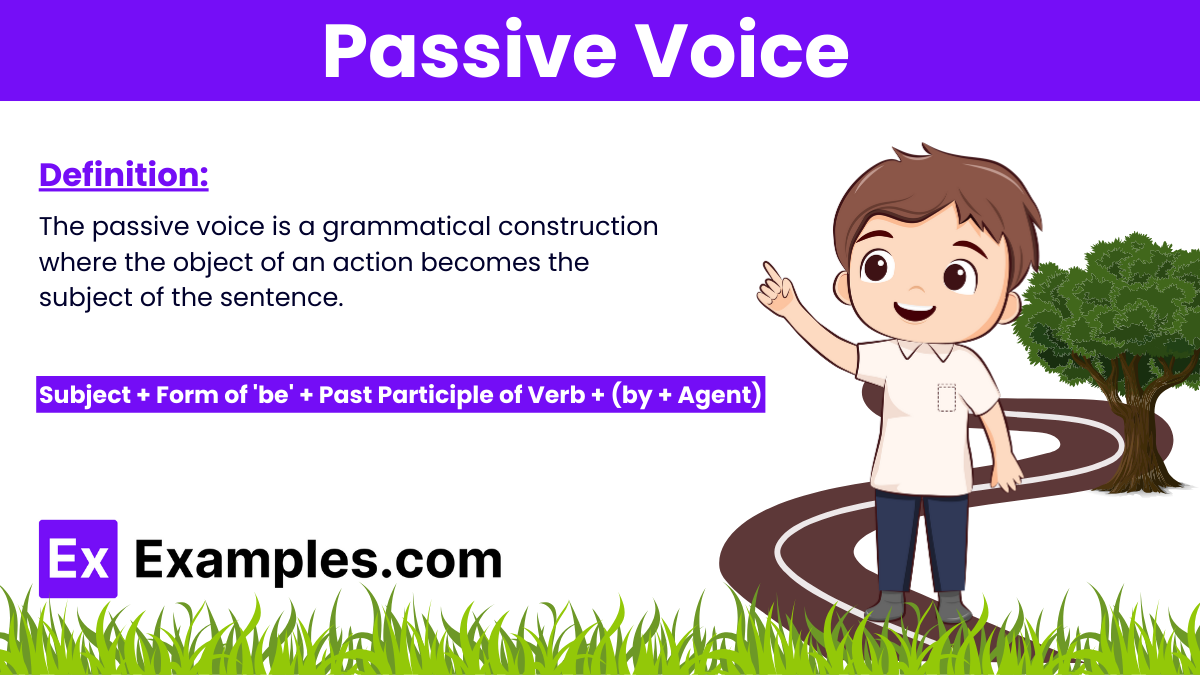100+ Passive Voice Examples
There are many types of writing styles a writer can adopt when writing a specific written output. One of these writing styles that a person can use in their writing is called a passive voice.
What is the passive voice?
The passive voice is a grammatical construction where the object of an action becomes the subject of the sentence. In passive voice sentences, the focus shifts from who is performing the action (the actor) to the recipient of the action. The actor is often either omitted or included in a prepositional phrase starting with “by.”
Structure of Passive Voice
The structure typically involves the verb “to be” in various tenses, followed by the past participle of the main verb. Here’s a basic formula:
Subject+form of ’be’+past participle+(by+agent)
Passive voice Formula with Examples
| Tense | Active Voice Formula | Passive Voice Formula |
|---|---|---|
| Simple Present | S + V1 (s/es) + O | S + am/is/are + V3 + by O |
| Simple Past | S + V2 + O | S + was/were + V3 + by O |
| Simple Future | S + will + V1 + O | S + will be + V3 + by O |
| Present Continuous | S + am/is/are + V-ing + O | S + am/is/are + being + V3 + by O |
| Past Continuous | S + was/were + V-ing + O | S + was/were + being + V3 + by O |
| Future Continuous | S + will be + V-ing + O | Rarely used in passive voice |
| Present Perfect | S + has/have + V3 + O | S + has/have been + V3 + by O |
| Past Perfect | S + had + V3 + O | S + had been + V3 + by O |
| Future Perfect | S + will have + V3 + O | S + will have been + V3 + by O |
| Present Perfect Cont. | S + has/have been + V-ing + O | S + has/have been being + V3 + by O |
| Past Perfect Cont. | S + had been + V-ing + O | Rarely used in passive voice |
| Infinitive | to + V1 + O | to be + V3 + by O |
| Gerund | V-ing + O | being + V3 + by O |
| Modal Verbs | S + modal (can, must, etc.) + V1 + O | S + modal + be + V3 + by O |
Examples:
| Tense | Active Voice | Passive Voice |
|---|---|---|
| Simple Present | They cook the meal. | The meal is cooked. |
| Simple Past | They cooked the meal. | The meal was cooked. |
| Future Simple | They will cook the meal. | The meal will be cooked. |
| Present Continuous | They are cooking the meal. | The meal is being cooked. |
| Past Continuous | They were cooking the meal. | The meal was being cooked. |
| Present Perfect | They have cooked the meal. | The meal has been cooked. |
| Past Perfect | They had cooked the meal. | The meal had been cooked. |
| Future Perfect | They will have cooked the meal. | The meal will have been cooked. |
| Modal Verbs (can, must, should, etc.) | They can cook the meal. | The meal can be cooked. |
Difference Between Active and Passive voice

| Aspect | Active Voice | Passive Voice |
|---|---|---|
| Definition | The subject performs the action. | The action is performed on the subject. |
| Focus | Focuses on the doer of the action. | Focuses on the receiver of the action or the action itself. |
| Structure | Subject + Verb + Object | Subject + Form of ‘be’ + Past Participle of Verb + (by + Agent) |
| Example | “The cat (subject) chased (verb) the mouse (object).” | “The mouse (subject) was chased (verb) by the cat (agent).” |
| Clarity and Directness | Generally more direct and clear. | Often less direct and can be vague if the agent is omitted. |
| Common Use | Preferred in most academic and professional writing for clarity. | Common in scientific or formal contexts where focus is on action. |
| Emphasis | Emphasizes the action’s performer. | Emphasizes the action or the recipient of the action. |
| Word Count | Typically uses fewer words. | Usually uses more words to convey the same meaning. |
| Passivity/Activity | Conveys a sense of activity and dynamism. | Often conveys passivity, making it suitable for objective writing. |
| Suitability | Ideal for most types of writing, including storytelling and news. | Preferred in technical reports and data-focused documents. |
| Example Sentences | “The researcher conducted the experiment.” | “The experiment was conducted by the researcher.” |
Passive Voice Rules
Understanding the passive voice can help improve your writing clarity and style. Here are the main rules and guidelines for using the passive voice:
1. Subject and Object Swap
- In passive voice, the object of an active sentence becomes the subject of the passive sentence.
- Active: “The cat chased the mouse.”
- Passive: “The mouse was chased by the cat.”
2. Use of Auxiliary Verbs
- Passive voice uses a form of the verb “to be” (am, is, are, was, were, be, being, been) followed by the past participle of the main verb.
- Example: “The book was written by the author.”
3. Focus on the Action
- Passive voice emphasizes the action or the recipient of the action rather than the doer.
- Example: “The cake was baked by her.”
4. Optional Agent
- The doer of the action (agent) can be omitted if it is unknown, unimportant, or obvious from the context.
- Example: “The window was broken.” (agent omitted)
5. Forming the Passive Voice
- Identify the object of the active sentence.
- Move the object to the subject position.
- Add the appropriate form of “to be.”
- Use the past participle of the main verb.
- Optionally include the original subject preceded by “by.”
6. Passive with Modal Verbs
- When using modal verbs (can, could, may, might, must, shall, should, will, would), the structure is: modal verb + be + past participle.
- Example: “The work can be finished by the team.”
7. Passive Voice in Different Tenses
- Present Simple: “The letter is written.”
- Past Simple: “The letter was written.”
- Future Simple: “The letter will be written.”
- Present Continuous: “The letter is being written.”
- Past Continuous: “The letter was being written.”
- Present Perfect: “The letter has been written.”
- Past Perfect: “The letter had been written.”
- Future Perfect: “The letter will have been written.”
8. Passive Voice with Infinitives
- Passive infinitives use “to be” + past participle.
- Example: “The report needs to be completed.”
9. Passive Gerunds
- Passive gerunds use “being” + past participle.
- Example: “She dislikes being interrupted.”
10. Avoiding Unnecessary Passive Voice
- Use active voice when clarity and conciseness are needed.
- Passive: “The meeting was scheduled by the manager.”
- Active: “The manager scheduled the meeting.”
Creative ways to use the Passive Voice in Writing
Using the passive voice creatively in writing can enhance the style, tone, and clarity of your narrative, especially when you want to emphasize the action or the object of the action rather than the doer.
1. Highlight the Action or Result
Passive voice can be used to put the focus on the action or its results rather than on who performed the action. This is particularly useful in scientific writing, formal documentation, or when the doer is unknown or unimportant.
- Example: “The masterpiece was painted over several months.”
2. Create an Air of Mystery
By omitting the doer, the passive voice can create a mysterious or suspenseful tone. This technique is often used in mystery and thriller genres to obscure identities and motives.
- Example: “The letters were delivered at midnight.”
3. Emphasize the Victim or Object of Action
In narratives where the experience of the subject is more important than who or what is acting upon it, the passive voice helps to emphasize the experience or suffering of the protagonist or object.
- Example: “The town was devastated by the hurricane.”
4. Formal Tone
The passive voice can lend a formal or academic tone to your writing, which is often required in scholarly articles, legal documents, and formal reports.
- Example: “A review of the literature was conducted to formulate the guidelines.”
5. Impersonal Construction
When you want to make statements impersonal and remove the subjectivity associated with the actor, the passive voice serves to neutralize and depersonalize the action.
- Example: “Mistakes were made during the project’s execution.”
6. Shift Focus
If you wish to shift the reader’s focus from the doer to the process or the recipient, the passive voice can be effectively utilized. This is often seen in process descriptions or instructions.
- Example: “The cake must be baked at 350 degrees for twenty minutes.”
7. Political or Sensitive Topics
In political or sensitive contexts, the passive voice can be used to avoid assigning direct blame or responsibility, which can be a diplomatic approach to potentially contentious issues.
- Example: “Regrettably, the files were deleted.”
8. Evoke a Sense of Ongoing Process
Passive constructions can give a sense of ongoing process or tradition, which is useful in historical or cultural discussions.
- Example: “Over the centuries, many legends have been told about this place.”
9. Stylistic Variation
Mixing active and passive constructions can add stylistic variety to your writing, preventing monotony and maintaining the reader’s interest.
- Example: “The experiment was set up carefully, and the scientists recorded the results meticulously.”
10. Enhance Descriptive Passages
Use the passive voice in descriptive passages to enhance the setting or background, making it more vivid and integral to the scene.
- Example: “The forest floor was carpeted with a thick layer of pine needles.”
How to identify the Passive Voice?
1. Look for the Verb “To Be”
- The passive voice often involves some form of the verb “to be” (am, is, are, was, were, be, being, been) used as an auxiliary verb.
- Example: The book was read by her.
2. Identify the Past Participle
- Check if the main verb of the sentence is in its past participle form (typically ending in -ed, -en, -d, -t, -n, or -ne).
- Example: The window was broken by the ball.
3. Find the Doer (Agent)
- Look for a “by” phrase, which, if present, usually indicates that the sentence is passive. The “by” phrase names the doer or agent of the action.
- Example: The song was sung by the choir.
4. Check the Subject
- See if the subject of the sentence is the recipient of the action rather than the doer. In passive voice, the subject is typically acted upon.
- Example: The letter was delivered yesterday.
5. Confirm Object Position
- In passive sentences, what would be the object in an active sentence becomes the subject.
- Example: A new policy has been implemented by the management.
6. Examine Sentence Focus
- Determine whether the focus of the sentence is on the action itself or the recipient of the action, rather than on who is performing the action.
- Example: Mistakes were made during the project.
7. Look for Missing Agents
- Passive constructions sometimes omit the agent completely, especially when the agent is unknown or irrelevant.
- Example: The window was broken.
8. Verb Phrasing Variety
- Consider if altering the sentence to include a typical action verb and a clear subject changes the clarity or meaning. This can help confirm if the passive voice is being used.
- Example: The mural was painted over the weekend.
9. Use of Prepositional Phrases
- Passive voice can be more verbose and often includes prepositional phrases starting with “by” that are not essential to the sentence’s core meaning.
- Example: The event will be attended by hundreds.
10. Sentence Reversibility Test
- A good test for passive voice is to try to reverse the sentence’s structure to make it active. If you can place the “by” phrase subject as the main subject and the sentence still makes logical sense, it is likely passive.
- Example: Original: The trophy was won by the team. Reversed: The team won the trophy.
Passive Voice Examples in Sentences
Here are examples of passive voice sentences across various contexts:
Everyday Activities
- The house was cleaned by Mary.
- Dinner is being cooked by John.
- The cake was baked by her.
- The song is being sung by the choir.
- The car is being washed by him.
Academic Context
- The experiment was conducted by the researchers.
- The essay is being written by the student.
- The book was read by the entire class.
- The homework was completed by the students.
- The project is being reviewed by the teacher.
Business Environment
- The report was submitted by the employee.
- The meeting is being scheduled by the manager.
- The contract was signed by the client.
- The presentation was given by the team.
- The email is being sent by her.
Technical Context
- The software was developed by the engineers.
- The website is being designed by the developers.
- The bug was fixed by the technician.
- The data is being analyzed by the analysts.
- The system was updated by the IT department.
Creative Writing
- The painting was created by the artist.
- The poem is being recited by the poet.
- The film was directed by the filmmaker.
- The novel was written by the author.
- The play is being performed by the actors.
Examples with Modal Verbs
- The work can be finished by the team.
- The project should be completed by next week.
- The task must be done by the end of the day.
- The document might be reviewed by the committee.
- The job will be done by the contractor.
Examples in Different Tenses
- Present Simple: The letter is written by her.
- Past Simple: The letter was written by her.
- Future Simple: The letter will be written by her.
- Present Continuous: The letter is being written by her.
- Past Continuous: The letter was being written by her.
- Present Perfect: The letter has been written by her.
- Past Perfect: The letter had been written by her.
- Future Perfect: The letter will have been written by her.
Passive Voice Examples in Literature
Here are examples of passive voice sentences in a literary context:
Classic Literature
- “The tale was told by an old man.”
- “The castle was surrounded by a thick fog.”
- “The mysterious letter was received by the protagonist.”
- “The battle was fought with great courage by the knights.”
- “The treasure was hidden in a secret chamber.”
Modern Fiction
- “The novel was written by a famous author.”
- “The decision was made without any explanation.”
- “The painting was admired by all who saw it.”
- “The news was spread quickly through the town.”
- “The secret was kept hidden for many years.”
Poetry
- “The poem was inspired by nature’s beauty.”
- “The song was sung by a chorus of angels.”
- “The stars were watched by lovers in the night.”
- “The story was passed down through generations.”
- “The dreams were woven into tales of wonder.”
Fantasy
- “The spell was cast by the ancient wizard.”
- “The dragon was slain by the brave hero.”
- “The prophecy was foretold by the oracle.”
- “The kingdom was ruled by a benevolent queen.”
- “The magical artifact was guarded by a fierce creature.”
Mystery and Suspense
- “The crime was investigated by the detective.”
- “The clues were found in the most unexpected places.”
- “The victim was discovered in the early morning hours.”
- “The plot was unraveled piece by piece.”
- “The truth was revealed at the end of the story.”
Passive Voice Examples in Business
Here are examples of passive voice sentences specifically in a business context:
- The report was submitted by the employee.
- The meeting is being scheduled by the manager.
- The contract was signed by the client.
- The presentation was given by the team.
- The email is being sent by her.
- The project was approved by the board.
- The budget is being reviewed by the finance department.
- The proposal was accepted by the committee.
- The training session is being conducted by the HR department.
- The new policy was implemented by the company.
- The website is being redesigned by the IT team.
- The invoice was paid by the customer.
- The marketing campaign is being launched by the agency.
- The feedback was received from the client.
- The product launch is being delayed by the supplier.
- The sales targets were met by the sales team.
- The complaint was handled by the customer service representative.
- The strategy is being developed by the consultants.
- The documents were signed by the CEO.
- The annual report is being prepared by the accounting department.
Passive Voice Examples in Writing
Here are examples of passive voice sentences in various contexts of writing:
Academic Writing
- “The experiment was conducted by the researchers.”
- “The results were analyzed by the data scientists.”
- “The theory was proposed by Dr. Smith.”
- “The findings were published in a reputable journal.”
- “The hypothesis was tested over several months.”
Business Writing
- “The report was submitted by the employee.”
- “The meeting is being scheduled by the manager.”
- “The contract was signed by the client.”
- “The presentation was given by the team.”
- “The budget is being reviewed by the finance department.”
Technical Writing
- “The software was developed by the engineering team.”
- “The bug was identified by the tester.”
- “The device was designed by the top engineers.”
- “The manual is being written by the technical writer.”
- “The update was installed by the IT department.”
Creative Writing
- “The painting was created by the artist.”
- “The poem is being recited by the poet.”
- “The film was directed by the renowned filmmaker.”
- “The novel was written by the famous author.”
- “The play is being performed by the actors.”
Legal Writing
- “The contract was drafted by the attorney.”
- “The case was reviewed by the judge.”
- “The verdict was delivered by the jury.”
- “The law was passed by the legislature.”
- “The agreement is being negotiated by both parties.”
Journalism
- “The news was reported by the journalist.”
- “The incident was captured on camera.”
- “The event was attended by many celebrities.”
- “The article was published in the morning edition.”
- “The interview is being conducted by the reporter.”
Scientific Writing
- “The cells were examined under a microscope.”
- “The vaccine was developed by the research team.”
- “The samples were collected from various locations.”
- “The study was funded by the government.”
- “The data is being processed by the computer.”
Everyday Writing
- “The house was cleaned by Mary.”
- “Dinner is being cooked by John.”
- “The cake was baked by her.”
- “The song is being sung by the choir.”
- “The car is being washed by him.”
More Passive Voice Examples:
1. Passive Voice Script
2. Passive Voice Practice
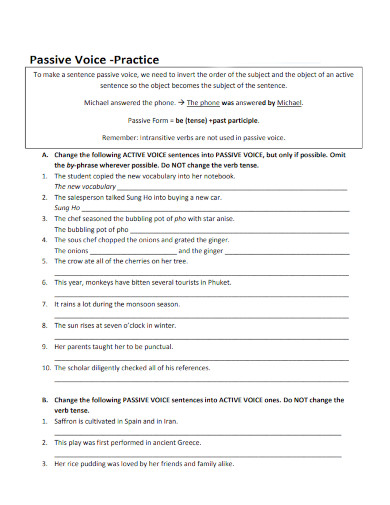
georgebrown.ca
3. Active and Passive Voice Scientific Writing
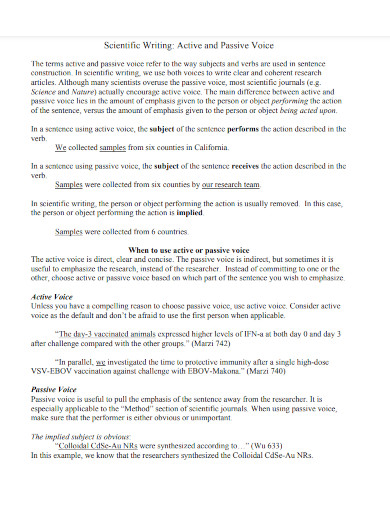
gwc.ucr.edu
4. Passive Voice Processing Instruction Revisited
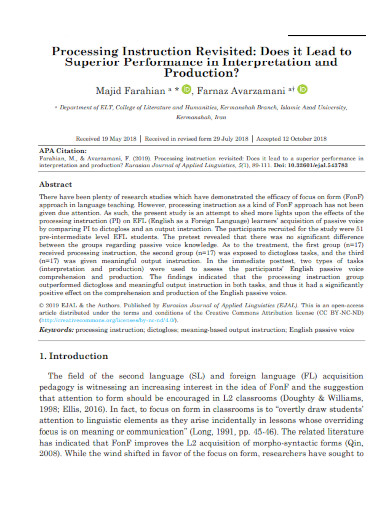
files.eric.ed.gov
5. Revealing Knowledge of the Passive Voice
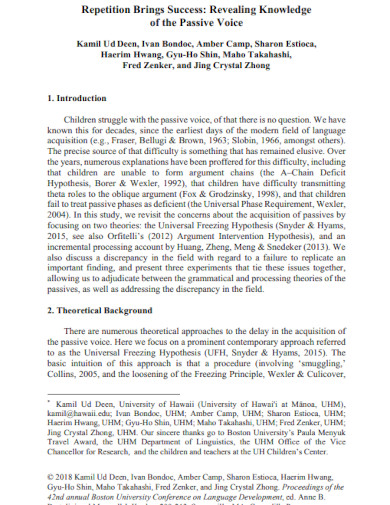
lingref.com
6. Tips for Active voice and Passive Voice

scu.edu
7. Passive Voice in Academic Writing
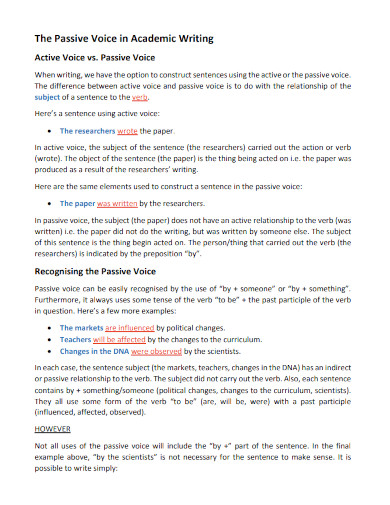
dcu.ie
8. Active and Passive Voice Exercise
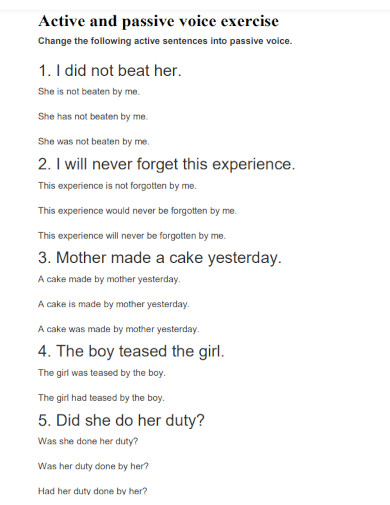
scmemorial.org
9. Understanding Passive Voice
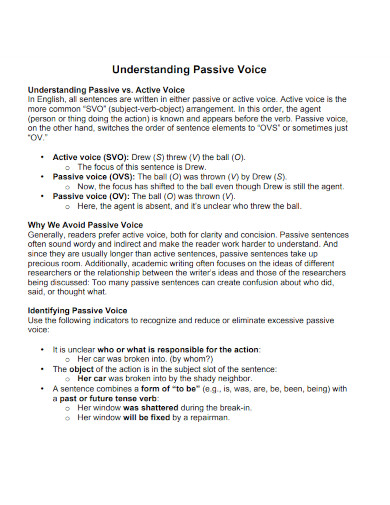
clas.ucdenver.edu
10. Learning to Use Passive Voice
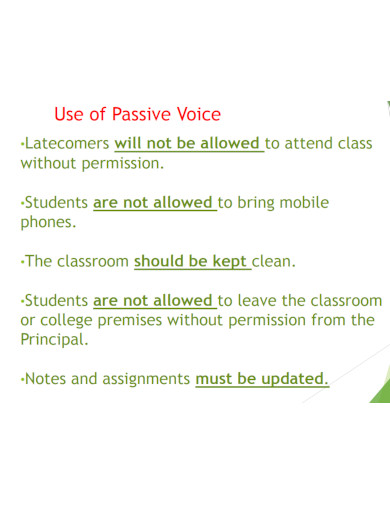
gfgc.kar.nic.in
11. Converting Passive Voice to Active Voice

yvcc.edu
How to Minimize Writing in The Passive Voice in Book Writing
A lot of professionals do not like seeing passive writing used in book writing as it will make one’s writing less direct and subtle. This means that one must actively minimize one’s proclivity in writing passive voice.
Step 1: Learn or Refresh Yourself About Passive and Active Voices
Begin by learning or refreshing one’s knowledge about voices in writing. This will help you innately know the concept of voices and will help improve your reflexes when using these voices in your writing.
Step 2: Practice Writing in Active Voice
One of the best ways to minimize one’s chances of reflexively writing in a passive voice is to practice intentionally writing in an active voice. This will build up one’s ability to write in an active voice without it being intentional.
Step 3: Use a Writing Software
Writing software helps one catch mistakes without needing to expend extra energy and thought into searching for mistakes. Examples of writing software include Grammarly and Prowritingaid.
Step 4: Practice Passive Voice Exercises and Worksheets
Like soft skills, people can integrate different techniques and practices into their writing to augment and improve the output. You can use various passive voice worksheets and exercises to help build up your writing skills.
Any clause can be Passive
Not every clause can be converted into passive voice effectively or appropriately. Here’s a clearer understanding of when a clause can be turned into passive voice and when it cannot:
Clauses Suitable for Passive Voice Conversion:
- Transitive Verbs:
- Only clauses with transitive verbs (verbs that require a direct object) can be converted into passive voice. This is because passive constructions shift the focus from the subject (the doer) to the object (the receiver) of the action.
- Example: Active: “The chef prepared the meal.” -> Passive: “The meal was prepared by the chef.”
Clauses Unsuitable for Passive Voice Conversion:
- Intransitive Verbs:
- Clauses that contain intransitive verbs (verbs that do not take a direct object) cannot be passivized. These verbs include actions like “sleep,” “arrive,” “go,” and “sit.”
- Example: Active: “He sleeps.” -> Passive: Incorrect to convert
- Linking Verbs:
- Clauses with linking verbs (verbs that connect the subject to a subject complement, such as “be,” “seem,” “become”) typically cannot be converted into passive voice. These verbs do not denote actions performed on an object but rather states of being.
- Example: Active: “She is a teacher.” -> Passive: Incorrect to convert
- Clauses Without a Clear Agent:
- If a clause does not include a clear agent performing the action, converting it into passive voice can make it awkward or overly vague.
- Example: Active: “People speak English here.” -> Passive: “English is spoken here.” (The agent ‘people’ is somewhat vague and general.)
Considerations:
- Contextual Appropriateness: Even if a clause can be technically converted into passive voice, it may not always be appropriate due to stylistic, contextual, or clarity considerations.
- Clarity and Emphasis: In many cases, using the passive voice may obscure who is responsible for an action, which can be undesirable in legal, technical, or academic writing where clarity of agency is crucial.
- Stylistic Choices: The decision between using active or passive constructions often depends on what you want to emphasize in your sentence, the tone you wish to convey, and how formally you need to present your information.
Passive Voice Misuse
Misusing the passive voice can complicate your writing and obscure your meaning. Here are some simple points outlining common misuses of the passive voice:
- Overuse in Writing:
- Excessive use of the passive voice can make text seem wordy, evasive, or overly formal.
- Lack of Clarity:
- Passive sentences often lack clarity because they hide the subject performing the action, making it hard for readers to follow who is responsible for what.
- Impersonal Tone:
- Frequent use can create an impersonal tone, which might not engage readers as effectively as a more direct, active voice.
- Decreased Readability:
- Texts dominated by passive constructions are generally harder to read and understand compared to those with active sentences.
- Inappropriate Contexts:
- Using the passive voice in situations that traditionally benefit from a strong, decisive tone (e.g., leadership articles, calls to action) can dilute the message’s impact.
- Redundancy and Verbosity:
- Passive sentences are typically more verbose than their active counterparts. This can lead to unnecessary redundancy in writing.
- Ambiguity About the Actor:
- When the doer of the action is omitted (often done in passive voice), it can lead to ambiguity, leaving readers guessing about responsibilities and roles.
- Inefficient Communication:
- Passive structures can impede the flow of information, making it less efficient, especially in procedural and instructional writing.
- Undermining Authority:
- Use in professional settings can unintentionally undermine the authority or expertise of the subject, as actions seem less assertive.
- Distortion of Intended Meaning:
- Misplacement of emphasis due to passive construction can distort the intended meaning, focusing on the wrong aspect of the sentence.
When to Use the Passive Voice?
The passive voice can be useful in various contexts for specific reasons. Here are some situations where using the passive voice is appropriate:
1. Emphasizing the Action or Result
- When the action or its result is more important than the doer.
- Example: “The project was completed on time.” (Focuses on the completion, not who completed it)
2. The Doer is Unknown or Unimportant
- When the doer of the action is unknown, irrelevant, or obvious from the context.
- Example: “The window was broken.” (The doer is unknown or unimportant)
3. Formal or Scientific Writing
- In formal or scientific writing, to maintain an objective tone and focus on the research or findings.
- Example: “The experiment was conducted to test the hypothesis.”
4. Avoiding Blame or Responsibility
- To avoid specifying who is responsible for an action, especially in sensitive or negative situations.
- Example: “Mistakes were made during the process.”
5. Creating a More Polite or Indirect Tone
- To make statements sound more polite or less direct.
- Example: “Your request has been received and is being processed.”
6. When the Doer is Obvious from Context
- When it’s clear who the doer is from the context, so mentioning them is redundant.
- Example: “The meeting was scheduled for 10 AM.” (By context, it is clear that the organizer did this)
7. Literary and Creative Writing
- To create a specific tone, style, or emphasis in literary and creative writing.
- Example: “The story was told by an old man.”
8. Highlighting a Change in State or Condition
- To focus on the change of state or condition of the subject.
- Example: “The water was heated to boiling point.”
9. Reporting Information or News
- In news reporting to focus on the event or information rather than the subject.
- Example: “The law was passed by the legislature.”
10. Technical or Instructional Writing
- To focus on the steps and procedures rather than the person performing them.
- Example: “The device should be turned off before cleaning.”
How to Use Passive Voice?
Using the passive voice involves rearranging the sentence to focus on the action or the recipient of the action rather than the doer. Here’s a step-by-step guide on how to form and use the passive voice effectively:
1. Identify the Object of the Active Sentence
- Find the object that receives the action in the active sentence.
- Active Example: “The chef cooks the meal.”
2. Move the Object to the Subject Position
- Place the object of the active sentence at the beginning of the passive sentence.
- Object Moved: “The meal”
3. Add the Appropriate Form of “To Be”
- Use the correct form of the verb “to be” based on the tense of the original sentence.
- Tense Conversion:
- Present Simple: am/is/are
- Past Simple: was/were
- Future Simple: will be
- Present Continuous: am/is/are being
- Past Continuous: was/were being
- Present Perfect: has/have been
- Past Perfect: had been
- Future Perfect: will have been
- Example: “The meal is” (Present Simple)
4. Use the Past Participle of the Main Verb
- Combine the form of “to be” with the past participle of the main verb.
- Example: “The meal is cooked”
5. Include the Agent (Optional)
- Add “by” followed by the doer of the action if it is important to specify who performed the action.
- Example: “The meal is cooked by the chef.”
What is passive voice?
Passive voice occurs when the subject of the sentence receives the action. Example: “The book was read by her.”
When should I use passive voice?
Use passive voice to emphasize the action, when the doer is unknown or unimportant, or to create an objective tone.
How do you form passive voice?
Form passive voice by using the appropriate form of “to be” + past participle of the main verb. Example: “The cake was baked.”
What are some examples of passive voice?
“The report was written by John.”
“The project is being reviewed.”
“The results have been published.”
Why is passive voice used in scientific writing?
Passive voice is used in scientific writing to maintain objectivity and focus on the action or results rather than the researcher.
How can I identify passive voice?
Look for a form of “to be” + past participle, and check if the subject is receiving the action. Example: “The letter was sent by him.”
Is passive voice always bad?
No, passive voice is not always bad. It is useful for emphasizing actions, creating an objective tone, and when the doer is unknown or irrelevant.
Can passive voice be used in different tenses?
Yes, passive voice can be used in various tenses: present, past, future, continuous, perfect. Example: “The letter is being written.”
How do I change a sentence from active to passive voice?
Swap the object to the subject position, use the correct form of “to be,” and add the past participle of the verb. Example: “She writes a letter” becomes “A letter is written by her.”
What is an example of passive voice in present continuous tense?
“The house is being cleaned by the maid.”



